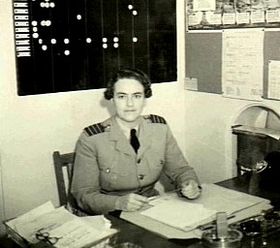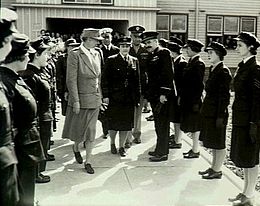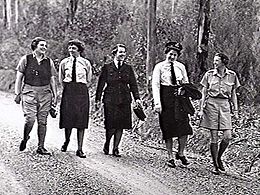- Clare Stevenson
-
Clare Grant Stevenson 
Group Officer Clare Stevenson, RAAF Headquarters, 1944Born 18 July 1903
Wangaratta, VictoriaDied 22 October 1988 (aged 85)
Sydney, New South WalesAllegiance  Commonwealth of Australia
Commonwealth of AustraliaService/branch  Royal Australian Air Force
Royal Australian Air ForceYears of service 1941–1946 Rank Group Officer Commands held WAAAF (1941–1946) Battles/wars World War II Awards Member of the Order of Australia
Member of the Order of the British EmpireOther work Executive, Berlei
Founder President, Carers NSWClare Grant Stevenson AM, MBE (18 July 1903 – 22 October 1988) was the inaugural Director of the Women's Auxiliary Australian Air Force (WAAAF). As such, she has been described as "the most significant woman in the history of the Air Force".[1] Formed as a branch of the Royal Australian Air Force (RAAF) in 1941, the WAAAF was the first and largest uniformed women's service in Australia during World War II, numbering more than 18,000 members by late 1944 and making up over thirty per cent of RAAF ground staff.
Born and educated in Victoria, Stevenson was an executive with the Berlei company when she was appointed Director of the WAAAF. Initially ranked Squadron Officer, she rose to become Group Officer by 1942. Stevenson resumed her civilian career following her discharge from the Air Force in 1946. Long active in education and social welfare, she helped form aid organisations including the Carers Association of New South Wales (now Carers NSW) after retiring from Berlei in 1960. Stevenson was appointed a Member of the Order of the British Empire and a Member of the Order of Australia for her services to the community and to female veterans.
Contents
Education and early career
Born in Wangaratta, Victoria, Clare Stevenson was the fifth of six children. When she was four her family moved to Essendon, where she attended Winstow Girls' Grammar School and Essendon High School,[2] completing her intermediate and leaving certificates.[3] In 1922, she was admitted to the Faculty of Science at the University of Melbourne, but switched to education after failing chemistry in her final year.[2][4] A hockey blue, Stevenson was active in a number of campus groups, including the Students' Representative Council and the Science Club. She became President of the Committee of Melbourne University Women, and graduated in 1925 with a Diploma of Education.[2]
Stevenson commenced her working life with the YWCA in 1926. A strong advocate of continuing education, during her first two years with the association she organised night classes for workers in Sydney,[3][4] before becoming General Secretary of the Rockhampton branch from 1929 to 1931.[2][5] In 1932 she took up a position as a training and research officer at Berlei, and from 1935 to 1939 represented the company in London as a senior executive.[4] Stevenson was based in Sydney when World War II broke out, in charge of product research and the training of sales staff.[3]
Director WAAAF
Appointment
Late in 1940, Stevenson was nominated to be the first Director of the planned Women's Auxiliary Australian Air Force (WAAAF).[3] Although keen to support the war effort in some capacity, she demurred due to the administrative and social obstacles she foresaw in the role. However her appointment went ahead regardless on 21 May 1941.[6] The Air Member for Personnel, Air Vice Marshal Henry Wrigley, had recommended Stevenson on the basis of her management background and because she was not a "socialite".[7] Despite her initial misgivings, Stevenson decided not to fight the appointment, which took effect on 9 June.[3][6]
Established on 25 March 1941 in response to lobbying by women wanting to serve in the war, and to free more male ground crew for overseas postings, the WAAAF was the first uniformed women's branch of an armed service in Australia, predating similar organisations in the Army and Navy.[4][5] Fewer than two hundred personnel had been recruited when Stevenson became Director in June;[8] this number would grow to around a thousand by the end of the year.[5] For the first three months of its existence the WAAAF had been under the temporary command of Flight Officer Mary Bell, wife of an RAAF Group Captain and former Australian Commandant of the Women's Air Training Corps, an organisation of female pilots and ground staff that had been formed in 1939 and had been providing voluntary support to the Air Force. Bell chose to resign on learning of Stevenson's appointment, rather than stay on as Deputy Director and report to someone from outside the service fraternity; she later rejoined on the condition that she would receive no promotion higher than Flight Officer.[5]
Early challenges
In her role as Director, Stevenson was responsible for training, morale and welfare of all WAAAF staff.[9] Philosophically committed to equal opportunity regardless of gender and social background,[10] from the outset she had to deal with discrimination by government authorities, many of whom had been against the creation of such a service. One-time Minister for Defence, Harold Thorby, declared that "aviation takes women out of their natural environment, the home and the training of the family",[3] and various senior Air Force officers, including the 'Father of the RAAF', Air Marshal Richard Williams, and the Director of Personnel Services, Group Captain Joe Hewitt, also fought the proposal. The Chief of the Air Staff, Air Chief Marshal Sir Charles Burnett, a Royal Air Force commander who appreciated how the Women's Auxiliary Air Force (WAAF) had proved itself during the Battle of Britain in 1940, supported its establishment but lost some interest after his preferred choice as Director, his daughter Sybil-Jean, a serving WAAF officer, was ruled out. The Federal government decreed that WAAAF staff would be paid two-thirds of what a male doing the equivalent trade received, while their right of appeal in disciplinary matters and the deference shown to their rank was more comparable to that of "uniformed civilians" than to servicemen.[11] Women were at first enrolled for renewable twelve-month periods rather than enlisted as permanent staff; only in 1943 did the WAAAF become part of the Permanent Air Force.[7]
Stevenson considered housing, uniforms, and recruit training as her first priorities after taking up her appointment. She said that on arriving at No. 1 WAAAF Depot in Malvern, Victoria, she was "shattered at the prison-like atmosphere of the place".[12] She drew on her retail experience to both organise the WAAAF and design its uniform.[10] Stevenson was promoted to Wing Officer in September 1941, and Group Officer in April 1942,[2] which was to be the highest rank attained by a serving WAAAF member.[13] She took an active interest in recruitment, her liberal social outlook evinced by her determination that single women with children should not be barred from entry to the WAAAF.[14] In order to establish high standards, Stevenson personally interviewed all WAAAF officer trainees and briefed as many of her officers as was possible before they were posted to a new job.[15] She also worked to maintain the morale of personnel, encouraging officers to attend group leadership courses and organise leisure and sporting activities for their staff.[16] Colonel Sybil Irving, head of the Australian Women's Army Service, later declared that Stevenson "did the most pertinent pioneering work" in gaining acceptance for women in the armed forces.[17]
Later service
 Stevenson (centre), flanked by American First Lady Eleanor Roosevelt (left) and Air Commodore Frank Lukis (right) in 1943
Stevenson (centre), flanked by American First Lady Eleanor Roosevelt (left) and Air Commodore Frank Lukis (right) in 1943
Early in 1943 a policy change was mooted to remove female officers from the technical musterings they had so far filled in the WAAAF, and substitute male officers in these roles. In opposing this, Stevenson went around the new Air Member for Personnel, Air Commodore Frank Lukis, and wrote directly to the Deputy Chief of the Air Staff, Air Commodore John McCauley. She told McCauley, "I contend that it is a waste of money and training to take women cipher officers, women from Signals (S4) and casualty ... when they have learnt their work and substitute these women by men who have to learn the job", and recommended that he direct the Air Member for Personnel to ensure that female officers continued to be employed in technical positions, and not simply for administration and welfare. McCauley agreed with Stevenson but Lukis appealed to the Chief of the Air Staff, Air Vice Marshal George Jones. Jones backed Lukis' authority, and the latter sent a "stinging rebuke" to Stevenson, who was forced to apologize.[18] In the event, women officers continued to be employed in technical positions as the WAAAF expanded over the next two years, peaking in strength at 18,667 members in October 1944.[4][19] By the end of the war a total of 27,000 women had served in the WAAAF, comprising some thirty-one per cent of Air Force ground staff and filling sixty-one trades, all previously occupied by men.[3]
Stevenson continued to lead the WAAAF following the cessation of hostilities, retiring on medical grounds on 22 March 1946.[3][4] Suffering reduced muscle function in her left arm and pain on the left side of her face and neck, she was diagnosed with brachial neuritis, traced to typhus, tetanus and smallpox injections received the previous May in preparation for a proposed visit to Manila that never eventuated. In her last annual address to the WAAAF as its Director, Stevenson encouraged its members to make use of their service experience when they returned to civilian life:
These are the things we shall miss—the comradeship, the knowledge of a common aim, the feeling that one is not alone—they all make life in the WAAAF very different from life in the outside world ... We must find a common aim—not of winning a war and working to free our prisoners of war—but winning something for our district from an unenlightened council or a disinterested public ...[20]Presented with a jewelled brooch as a farewell gift by her fellow officers, Stevenson asked that its value instead be put towards a scholarship for an ex-WAAAF member to study social work at the University of Sydney.[21] The WAAAF itself, the first and largest of Australia's wartime women's services, was disbanded on 30 September 1946.[4][22] It was succeeded in 1950 by a new organisation with a separate charter to the RAAF, the Women's Royal Australian Air Force (WRAAF).[22]
Post-war work and legacy
Following her discharge from the WAAAF, Stevenson resumed her career as a senior executive with Berlei, and remained with the company until her retirement in 1960. Parallel to her work at Berlei, she was a Trustee of the Services Canteens Trust Fund in Melbourne, maintaining her links with the organisation for the next forty years.[4][23] A founding patron of the Council of Ex-Servicewomen's Associations,[2][23] Stevenson was appointed a Member of the Order of the British Empire in the 1960 Queen's Birthday Honours for her welfare work on behalf of female veterans.[24] She helped set up the Scholarship Trust Fund for Civilian Widows' Children in 1963, and was a Research Officer with the New South Wales Council on the Ageing (COTA) from 1969 to 1978.[23] In 1975, Stevenson was involved in establishing the Kings Cross Community Aid and Information Service, serving for a time as its President and as a member of the Management Committee until 1987.[4]
Stevenson founded the Carers Association of New South Wales, and became its first President, in 1980. While serving with COTA in 1974, she had prepared a report titled "Dedication" concerning the levels of assistance given to the elderly by their family and friends. This led to her forming a subcommittee of COTA made up of those she called 'carers' in 1976, from which she later created the Carers Association as an independent organisation. As president of the association, Stevenson lobbied for the establishment of a Carers Pension in New South Wales, which was legislated in 1985.[25] She is commemorated at the Carers Association (now Carers NSW) by the Clare Stevenson Memorial Lectures.[26]
In 1984 Stevenson, together with Honor Darling, published The W.A.A.A.F. Book, a collection of reminiscences by former members of the service.[2] Stevenson was appointed a Member of the Order of Australia in the 1988 Australia Day Honours for her services to the community and her welfare work with veterans.[27] Her hobbies included reading, classical music and, in her younger days, surfing.[23][28] Unmarried, Clare Stevenson died in Sydney on 22 October 1988.[4]
Notes
- ^ Stephens, The Royal Australian Air Force, p.155
- ^ a b c d e f g Stevenson, Clare Grant (1903 - 1988) at National Foundation for Australian Women. Retrieved on 10 January 2009.
- ^ a b c d e f g h Stephens & Isaacs, High Fliers, pp.76–79
- ^ a b c d e f g h i j Group Officer Clare Grant Stevenson at Australian War Memorial. Retrieved on 9 January 2009.
- ^ a b c d Gillison, Royal Australian Air Force 1939–1942, pp.99–100
- ^ a b Thomson, The WAAAF in Wartime Australia, p.338
- ^ a b Dennis et al., The Oxford Companion to Australian Military History, p.606
- ^ Hasluck, The Government and the People 1939–1941, pp.405–407
- ^ Thomson, The WAAAF in Wartime Australia, p.91
- ^ a b Newman, The Women's Auxiliary Australian Air Force, p.52
- ^ Thomson, The WAAAF in Wartime Australia, pp.68–72
- ^ Thomson, The WAAAF in Wartime Australia, p.100
- ^ Thomson, The WAAAF in Wartime Australia, p.334
- ^ Thomson, The WAAAF in Wartime Australia, p.137
- ^ Adam-Smith, Australian Women at War, p.236
- ^ Thomson, The WAAAF in Wartime Australia, pp.290–291
- ^ Dennis et al., The Oxford Companion to Australian Military History, p.513
- ^ Thomson, The WAAAF in Wartime Australia, pp.218–219
- ^ Thomson, The WAAAF in Wartime Australia, pp.219–221
- ^ Thomson, The WAAAF in Wartime Australia, pp.306–307
- ^ Fink, "Clare Stevenson: A Gentle Giant of a Woman"
- ^ a b Stephens, The Royal Australian Air Force, pp.203–205
- ^ a b c d Draper, Who's Who in Australia 1985, p.806
- ^ London Gazette: no. 42052. p. 4011. 3 June 1960. Retrieved 9 January 2009.
- ^ Carers NSW 25 Years: 1975-2000, a retrospective at Carers NSW. Retrieved on 12 January 2009.
- ^ Clare Stevenson Memorial Lectures at Carers NSW. Retrieved on 12 January 2009.
- ^ Stevenson, Clare Grant: Member of the Order of Australia at It's an Honour. Retrieved on 9 January 2009.
- ^ Chisholm, Who's Who in Australia 1947, p.784
References
- Adam-Smith, Patsy (1984). Australian Women at War. Melbourne: Thomas Nelson Australia. ISBN 0170064085.
- Chisholm, Alec H. (ed.) (1947). Who's Who in Australia 1947. Melbourne: The Herald and Weekly Times.
- Dennis, Peter; Grey, Jeffrey; Morris, Ewan; Prior, Robin (2008) [1995]. The Oxford Companion to Australian Military History. South Melbourne: Oxford University Press. ISBN 9780195517842.
- Draper, W.J. (ed.) (1985). Who's Who in Australia 1985. Melbourne: The Herald and Weekly Times. ISSN 08108226.
- Fink, Averil (27 November 1997). "Clare Stevenson: A Gentle Giant of a Woman". 1997 Clare Stevenson Memorial Lecture. Sydney: Carers NSW.
- Gillison, Douglas (1962). Australia in the War of 1939-1945: Series Three (Air) Volume I – Royal Australian Air Force 1939–1942. Canberra: Australian War Memorial. http://www.awm.gov.au/histories/chapter.asp?volume=26.
- Hasluck, Paul (1962). Australia in the War of 1939-1945: Series Four (Civil) Volume I – The Government and the People 1939–1941. Canberra: Australian War Memorial. http://www.awm.gov.au/histories/chapter.asp?volume=30.
- Newman, Carolyn (2002). "The Women's Auxiliary Australian Air Force". Wartime (Canberra: Australian War Memorial) (17). ISSN 13282727.
- Stephens, Alan (2006) [2001]. The Royal Australian Air Force: A History. London: Oxford University Press. ISBN 0195555414.
- Stephens, Alan; Isaacs, Jeff (1996). High Fliers: Leaders of the Royal Australian Air Force. Canberra: Aust. Govt. Pub. Service. ISBN 0644456825.
- Thomson, Joyce (1991). The WAAAF in Wartime Australia. Melbourne: Melbourne University Press. ISBN 0522845258.
Further reading
- Stevenson, Clare; Darling, Honor (1984). The W.A.A.A.F. Book. Sydney: Hale & Iremonger. ISBN 0868061514.
Categories:- 1903 births
- 1988 deaths
- Royal Australian Air Force personnel of World War II
- Members of the Order of Australia
- Members of the Order of the British Empire
- People from Victoria (Australia)
- Royal Australian Air Force officers
- Women in the Australian military
Wikimedia Foundation. 2010.



